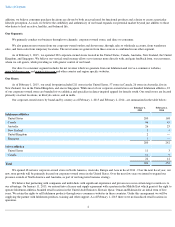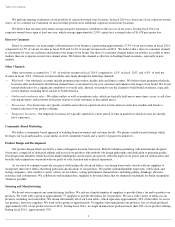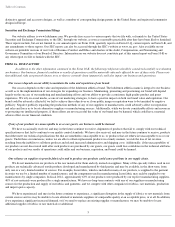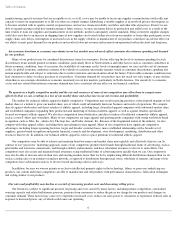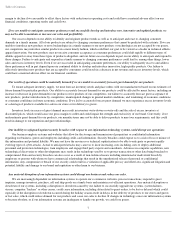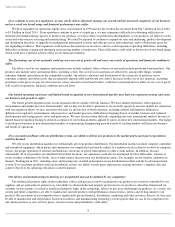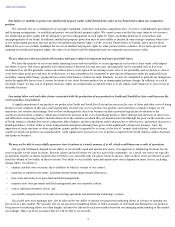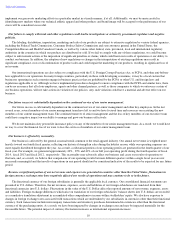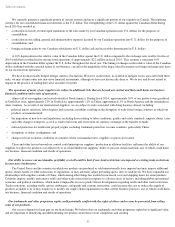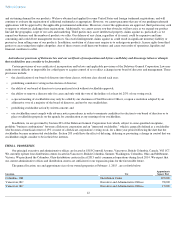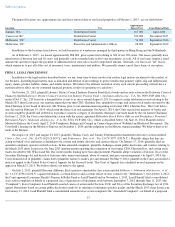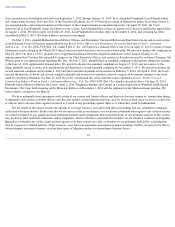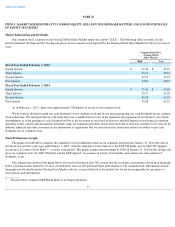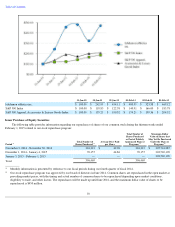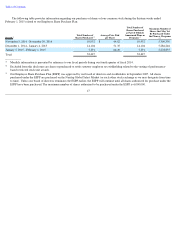Lululemon 2014 Annual Report Download - page 13
Download and view the complete annual report
Please find page 13 of the 2014 Lululemon annual report below. You can navigate through the pages in the report by either clicking on the pages listed below, or by using the keyword search tool below to find specific information within the annual report.
Table of Contents
Our failure or inability to protect our intellectual property rights could diminish the value of our brand and weaken our competitive
position.
We currently rely on a combination of copyright, trademark, trade dress and unfair competition laws, as well as confidentiality procedures
and licensing arrangements, to establish and protect our intellectual property rights. We cannot assure you that the steps taken by us to protect
our intellectual property rights will be adequate to prevent infringement of such rights by others, including imitation of our products and
misappropriation of our brand. In addition, intellectual property protection may be unavailable or limited in some foreign countries where laws
or law enforcement practices may not protect our intellectual property rights as fully as in the United States or Canada, and it may be more
difficult for us to successfully challenge the use of our intellectual property rights by other parties in these countries. If we fail to protect and
maintain our intellectual property rights, the value of our brand could be diminished and our competitive position may suffer.
We are subject to risks associated with leasing retail space subject to long-term and non-cancelable leases.
We lease the majority of our stores under operating leases and our inability to secure appropriate real estate or lease terms could impact
our ability to grow. Our leases generally have initial terms of between five and ten years, and generally can be extended only in five-year
increments if at all. We generally cannot cancel these leases at our option. If an existing or new store is not profitable, and we decide to close it,
as we have done in the past and may do in the future, we may nonetheless be committed to perform our obligations under the applicable lease
including, among other things, paying the base rent for the balance of the lease term. Similarly, we may be committed to perform our obligations
under the applicable leases even if current locations of our stores become unattractive as demographic patterns change. In addition, as each of
our leases expire, we may fail to negotiate renewals, either on commercially acceptable terms or at all, which could require us to close stores in
desirable locations.
Increasing labor costs and other factors associated with the production of our products in South and South East Asia could increase the
costs to produce our products.
A significant portion of our products are produced in South and South East Asia and increases in the costs of labor and other costs of doing
business in the countries in this area could significantly increase our costs to produce our products and could have a negative impact on our
operations, net revenue and earnings. Factors that could negatively affect our business include a potential significant revaluation of the
currencies used in these countries, which may result in an increase in the cost of producing products, labor shortage and increases in labor costs,
and difficulties in moving products manufactured out of the countries in which they are manufactured and through the ports on the western coast
of North America, whether due to port congestion, labor disputes, product regulations and/or inspections or other factors, and natural disasters or
health pandemics. A labor strike or other transportation disruption affecting these ports could significantly disrupt our business. Also, the
imposition of trade sanctions or other regulations against products imported by us from, or the loss of "normal trade relations" status with any
country in which our products are manufactured, could significantly increase our cost of products imported into North America and/or Australia
and harm our business.
We may not be able to successfully open new store locations in a timely manner, if at all, which could harm our results of operations.
Our growth will largely depend on our ability to successfully open and operate new stores. Our approach to identifying locations for our
stores typically favors street locations, lifestyle centers and malls where we can be a part of the community. As a result, our stores are typically
located near retailers or fitness facilities that we believe are consistent with our guests' lifestyle choices. Sales at these stores are derived, in part,
from the volume of foot traffic in these locations. Our ability to successfully open and operate new stores depends on many factors, including,
among others, our ability to:
Successful new store openings may also be affected by our ability to initiate our grassroots marketing efforts in advance of opening our
first store in a new market. We typically rely on our grassroots marketing efforts to build awareness of our brand and demand for our products.
Our grassroots marketing efforts are often lengthy and must be tailored to each new market based on our emerging understanding of the market.
Accordingly, there can be no assurance that we will be able to successfully
9
•
identify suitable store locations, the availability of which is outside of our control;
•
negotiate acceptable lease terms, including desired tenant improvement allowances;
•
hire, train and retain store personnel and field management;
•
immerse new store personnel and field management into our corporate culture;
•
source sufficient inventory levels; and
•
successfully integrate new stores into our existing operations and information technology systems.





